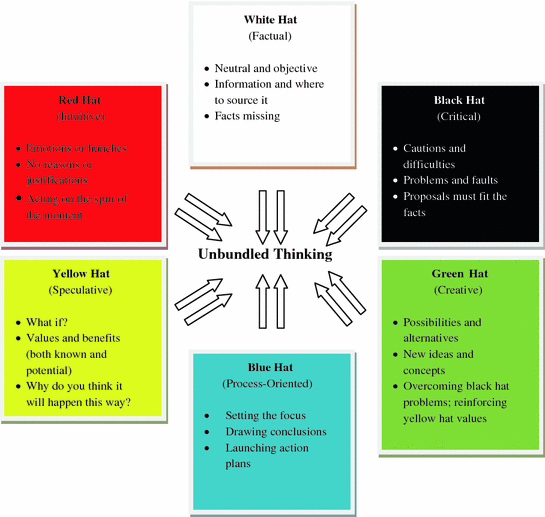Abstract
The difference between poor and effective teams lies not so much in their collective mental equipment but in how well they use their abilities to think together. The Six Thinking Hats technique helps actualize the thinking potential of teams.
You have full access to this open access chapter, Download chapter PDF
Similar content being viewed by others
Keywords
In a Word The difference between poor and effective teams lies not so much in their collective mental equipment but in how well they use their abilities to think together. The Six Thinking Hats technique helps actualize the thinking potential of teams.

Introduction
Routinely, many people think from analytical, critical, logical perspectives, and rarely view the world from emotional, intuitive, creative, or even purposely negative viewpoints. As a result, their arguments do not make leaps of imagination, they underestimate resistance to change, or they fail to draw contingency plans.
Lateral thinking Footnote 1 is reasoning that offers new ways of looking at problems—coming at them from the side rather than from the front—to foster change, creativity , and innovation . One tool of lateral thinking, the Six Thinking Hats technique, was devised by Edward de Bono in 1985 to give groups a means to reflect together more effectively, one thing at a time.
Six Hats, Six Colors
The Six Thinking Hats technique involves the use of metaphorical hats in discussions.Footnote 2 Participants put on hats in turn, possibly more than once but not necessarily all of them, to indicate directions (not descriptions) of thinking. The color of each is related to a function
-
White hat thinking—neutral, objective—focuses on the data and information that are available or needed.
-
Red hat thinking—emotional—looks at a topic from the point of view of emotions, feelings, and hunches, without having to qualify or justify them.
-
Black hat thinking—somber, serious—uses experience, logic, judgment, and caution to examine the difficulties and problems associated with a topic and the feasibility of ideas.
-
Yellow hat thinking—sunny, positive—is concerned with benefits and values.
-
Green hat thinking—growth, fertility—intimates creative thinking and movement, not judgment, to generate new ideas and solutions.
-
Blue hat thinking—cool, the sky above—concentrates on reflection, metacognition (thinking about the thinking required), and the need to manage the thinking process.Footnote 3

Fig. Wearing six thinking hats. Source Author
Applications
Pertinent applications for the Six Thinking Hats technique include team productivity and communication; product and process improvement, as well as project management; critical and analytical thinking, problem solving , and decision-making; and creativity training, meeting facilitation, and meeting management.
Benefits
The Six Thinking Hats technique provides a common language that works in different cultures. It promotes collaborative thinking, sharpens focus, facilitates communication, reduces conflict, enables thorough evaluations, improves exploration, fosters creativity and innovation , saves time, and boosts productivity.
Discipline
Discipline is important. The facilitator’s role is to define the focus of the thinking, plan the sequence and timing of the thinking, ask for changes in the thinking if needed, handle requests from participants for changes in the thinking, and form periodic or final summaries of the thinking for consideration by participants. Each participant must follow the lead of the facilitator, stick to the hat being used, try to work within time limits, and contribute honestly and fully under each hat.
Notes
- 1.
The term was coined by Edward de Bono in 1967.
- 2.
The larger benefits lie in conversations. But the technique can be also used by an individual.
- 3.
A blue hat should always be used both at the beginning and at the end of a discussion. What follows it depends on the nature of the topic and emotions about it. For instance, wearing a red hat next might defuse strong feelings. Discussions to brainstorm problems might adopt blue, white, green, red, yellow, black, green, and blue hats in sequence. Conversations seeking feedback might follow a blue, black, green, and blue hat pattern.
Further Reading
De Bono E (1999) Six thinking hats. Back Bay Books
Author information
Authors and Affiliations
Corresponding author
Rights and permissions
The opinions expressed in this chapter are those of the author(s) and do not necessarily reflect the views of the Asian Development Bank, its Board of Directors, or the countries they represent.
Open Access This chapter is licensed under the terms of the Creative Commons Attribution-NonCommercial 3.0 IGO license (http://creativecommons.org/licenses/by-nc/3.0/igo/) which permits any noncommercial use, sharing, adaptation, distribution and reproduction in any medium or format, as long as you give appropriate credit to the Asian Development Bank, provide a link to the Creative Commons license and indicate if changes were made.
Any dispute related to the use of the works of the Asian Development Bank that cannot be settled amicably shall be submitted to arbitration pursuant to the UNCITRAL rules. The use of the Asian Development Bank’s name for any purpose other than for attribution, and the use of the Asian Development Bank’s logo, shall be subject to a separate written license agreement between the Asian Development Bank and the user and is not authorized as part of this CC-IGO license. Note that the link provided above includes additional terms and conditions of the license.
The images or other third party material in this chapter are included in the chapter’s Creative Commons license, unless indicated otherwise in a credit line to the material. If material is not included in the chapter’s Creative Commons license and your intended use is not permitted by statutory regulation or exceeds the permitted use, you will need to obtain permission directly from the copyright holder.
Copyright information
© 2017 Asian Development Bank
About this chapter
Cite this chapter
Serrat, O. (2017). Wearing Six Thinking Hats. In: Knowledge Solutions. Springer, Singapore. https://doi.org/10.1007/978-981-10-0983-9_67
Download citation
DOI: https://doi.org/10.1007/978-981-10-0983-9_67
Published:
Publisher Name: Springer, Singapore
Print ISBN: 978-981-10-0982-2
Online ISBN: 978-981-10-0983-9
eBook Packages: Business and ManagementBusiness and Management (R0)





